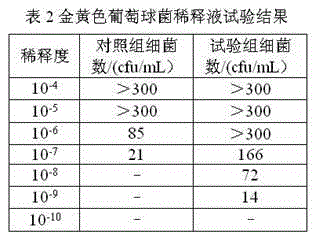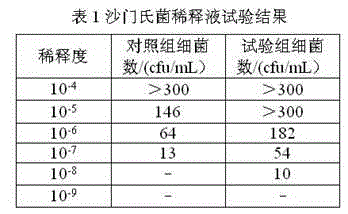Method for detecting salmonella and staphylococcus aureus in food simultaneously
A technology for Salmonella and Staphylococcus, which is applied in the field of microbial detection, can solve the problems of simultaneous detection of Salmonella and Staphylococcus aureus, long detection time, low sensitivity, etc., to improve the coupling efficiency of magnetic beads, easy to operate, and reduce interference Effect
- Summary
- Abstract
- Description
- Claims
- Application Information
AI Technical Summary
Problems solved by technology
Method used
Image
Examples
Embodiment 1
[0027] Embodiment 1 Effect test of aminotriacetic acid solution
[0028] After the standard strain of Salmonella (CMCC 50115) and the standard strain of Staphylococcus aureus (ATCC6538) were cultured overnight, they were diluted in a 10-fold gradient, and 10 -4 —10 -9 and 10 -4 —10 -10 Dilution for immunomagnetic bead sensitivity test. Divide the dilutions of each gradient of the two strain culture solutions into the test group and the control group. The control group added EDTA solution with a mass concentration of 65%. The volume ratio of the dilution solution to the EDTA solution was 6:1, and the test group added The mass concentration is 50% aminotriacetic acid solution, the volume ratio of diluent and aminotriacetic acid solution is 6:1, and the test steps are as follows:
[0029] 1) Take 100 μL of each gradient dilution solution and add 200 μL of immunomagnetic beads to mix well, incubate with slow shaking at 37°C for 20 minutes, let stand on the magnetic stand for ...
Embodiment 2
[0037] A method for simultaneously detecting salmonella and staphylococcus aureus in milk, comprising the following steps:
[0038] 1) Take 25mL of the milk sample to be tested, add 225mL of PBS buffer, shake for 30s, adjust the pH to 7 with 1mol / mL sterile NaOH solution to obtain a homogeneous sample; add 50.0ml of 50 wt % aminotriacetic acid to the homogenous sample Solution, after oscillating by ultrasonic wave at 37°C for 5 minutes (ultrasonic frequency 20KHz), washed with 0.01 mol / LPBS buffer solution, centrifuged at 8000r / min for 5 minutes, separated into layers, and discarded the upper layer;
[0039] 2) Take 100 μL of the sample treated in step 1) and add 200 μL of immunomagnetic beads (magnetic beads obtained by coupling streptavidin-modified magnetic beads with biotin-labeled Salmonella and Staphylococcus aureus antibodies) to mix and shake at 37°C After 20 minutes, let stand on the magnetic stand for 2 minutes to separate layers, discard the upper layer, wash the lo...
Embodiment 3
[0042] A method for simultaneously detecting salmonella and staphylococcus aureus in eggs, comprising the following steps:
[0043] 1) Rinse the shell of the egg to be tested with running water, then wipe and disinfect it with 75% alcohol cotton ball, take 25mL egg liquid, add it to 225mL PBS buffer solution, beat it with a slap-type homogenizer for 60s, and adjust it with 1mol / mL sterile NaOH solution. pH to 7, to obtain a sample homogeneous solution; add 45.5mL 50wt% aminotriacetic acid solution to the sample homogeneous solution, oscillate for 5min at 37°C with ultrasonic waves (ultrasonic frequency 20KHz), wash twice with 0.01mol / L PBST buffer, Centrifuge at 8000r / min for 5min, separate into layers, and discard the upper layer;
[0044] 2) Take 100 μL of the sample treated in step 1) and add 200 μL of immunomagnetic beads (magnetic beads obtained by coupling streptavidin-modified magnetic beads with biotin-labeled Salmonella and Staphylococcus aureus antibodies), mix and ...
PUM
 Login to View More
Login to View More Abstract
Description
Claims
Application Information
 Login to View More
Login to View More - R&D
- Intellectual Property
- Life Sciences
- Materials
- Tech Scout
- Unparalleled Data Quality
- Higher Quality Content
- 60% Fewer Hallucinations
Browse by: Latest US Patents, China's latest patents, Technical Efficacy Thesaurus, Application Domain, Technology Topic, Popular Technical Reports.
© 2025 PatSnap. All rights reserved.Legal|Privacy policy|Modern Slavery Act Transparency Statement|Sitemap|About US| Contact US: help@patsnap.com



